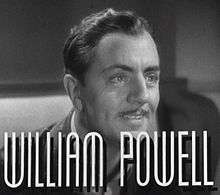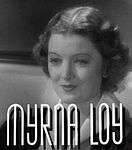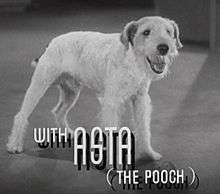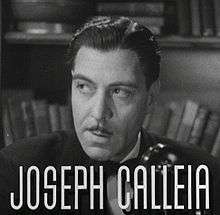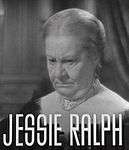After the Thin Man
| After the Thin Man | |
|---|---|
 Theatrical release poster | |
| Directed by | W.S. Van Dyke |
| Produced by | Hunt Stromberg |
| Written by | Dashiell Hammett (characters, story) |
| Screenplay by |
Albert Hackett Frances Goodrich |
| Starring |
William Powell Myrna Loy James Stewart Penny Singleton Elissa Landi |
| Music by | William Axt |
| Cinematography | Oliver T. Marsh |
| Edited by | Robert Kern |
| Distributed by | Metro-Goldwyn-Mayer |
Release dates | December 25, 1936 |
Running time | 113 minutes |
| Country | United States |
| Language | English |
| Budget | $673,000 (est.)[1] |
| Box office | $3,165,000 (worldwide est.)[1] |
After the Thin Man is a 1936 American film, starring William Powell, Myrna Loy, and James Stewart, that is the sequel to the film The Thin Man. The movie presents Powell and Loy as Dashiell Hammett's characters Nick and Nora Charles. The film was directed by W. S. Van Dyke and also featured Elissa Landi, Joseph Calleia, Jessie Ralph, Alan Marshal, and Penny Singleton.
This was actually the sixth pairing for Myrna Loy and William Powell. The two made 14 pictures together, six of them in the Thin Man series.[2]
Plot
Nick and Nora Charles return from vacation to their home in San Francisco on New Year's Eve, where Nora's stuffy family expect the couple to join them for a formal dinner. Nick is despised by Nora's Aunt Katherine, the family matriarch, as his immigrant heritage and experience as a "flat foot" are considered below Nora. The true reason for their invitation is that Nora's cousin Selma's ne'er-do-well husband Robert has been missing. Nick is coerced into a little quiet detective work for the family.
They easily find Robert at a Chinese nightclub, where he's been conducting an affair with Polly, the star performer. Robert tries to extort money from Selma's unrequited love, David Graham (James Stewart): $25,000 and Robert will leave Selma alone permanently. Unknown to Robert, Polly and the nightclub's owner, Dancer, plan to grift the money and dispose of him. After being paid off, and returning home for some clothes, Robert is shot at the stroke of midnight. David finds Selma standing over Robert and hurriedly disposes of her gun. Despite this, the police determine that she's the prime suspect, and her fragile mental state only strengthens the case. Selma insists that she never fired her gun, and Nick is now obliged to investigate and determine the true murderer.
As suspects pile up, schemes and double-crosses are found and two more murders occur, including Polly's brutal brother. Lt. Abrams (Sam Levene, making his series debut) readily accepts Nick's assistance. Nick follows a trail of clues that lead him to the apartment of a mysterious "Anderson". As in the previous film, the film climaxes with a final interrogation and denouement featuring all the suspects. The murderer is revealed to be David (the mysterious "Anderson"), who has harbored a vengeful hatred of Selma after she passed him over to marry Robert. The case solved, and once again traveling by train, Nora reveals to Nick that they are expecting a baby, although Nick has to be prodded into putting the "clues" together and she comments: "And you call yourself a detective."
Cast

The cast is listed in order as documented by the American Film Institute.[3]
- William Powell as Nick Charles
- Myrna Loy as Nora Charles
- James Stewart as David Graham
- Elissa Landi as Selma Landis
- Joseph Calleia as "Dancer"
- Jessie Ralph as Aunt Katherine Forrest
- Alan Marshal as Robert Landis
- Teddy Hart as Casper
- Sam Levene as Lieutenant Abrams
- Dorothy McNulty (AKA-Penny Singleton) as Polly Byrnes
- William Law as Lum Kee
- George Zucco as Dr. Kammer
- Paul Fix as Phil Byrnes
- Skippy as Asta
- Dorothy Vaughan as Charlotte (uncredited)
- Maude Turner Gordon as Helen (uncredited)
- William Burress as Lucius (uncredited)
- Tom Ricketts as Henry, the butler (uncredited)
- Esther Howard LiChi Club patron who says "Hey, handsome" to William Powell (uncredited)
Production
The film's story was written by Dashiell Hammett, based on his characters Nick and Nora, but not a particular novel or short story. Albert Hackett and Frances Goodrich wrote the screenplay.
Reception
The film was nominated for an Oscar in 1937 for Best Writing, Screenplay.[4] It is often referred to as the best of the Thin Man sequels.
Box office
The film grossed a total (domestic and foreign) of $3,165,000: $1,992,000 from the US and Canada and $1,173,000 elsewhere. It made a profit of $1,516,000.[1]
References
- 1 2 3 Sedgwick, John (2000). Popular Filmgoing in 1930s Britain: A Choice of Pleasures. University of Exeter Press. ISBN 9780859896603. Retrieved August 7, 2014.
- ↑ "After the Thin Man (1936)". Turner Classic Movies. Retrieved November 4, 2015.
- ↑ "After the Thin Man". AFI Catalog of Feature Films. American Film Institute. Retrieved 2016-02-06.
- ↑ Awards for After The Thin Man at the Internet Movie Database
External links
| Wikimedia Commons has media related to After the Thin Man (film). |
- After the Thin Man at the Internet Movie Database
- Plot overview
- After the Thin Man at the TCM Movie Database
- After the Thin Man at the American Film Institute Catalog
- After the Thin Man on Lux Radio Theater: June 17, 1940
